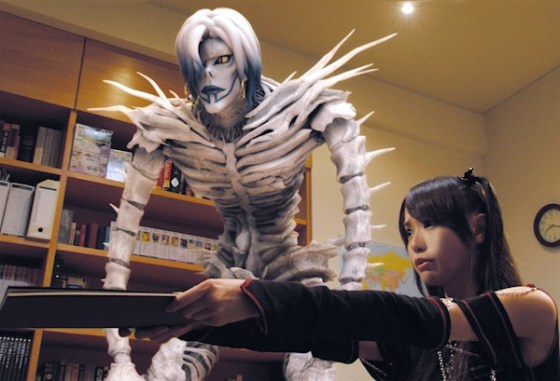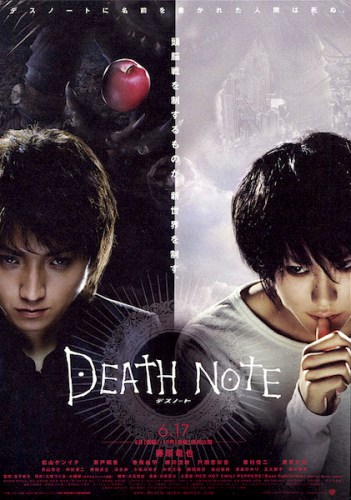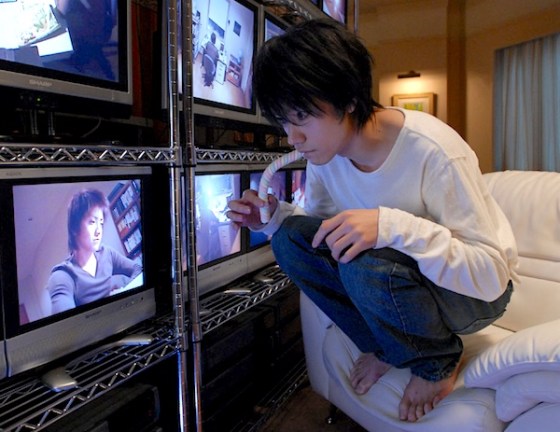Shūsuke Kaneko | 135 mins | DVD | 16:9 | Japan / Japanese | 12

Picking up immediately after the first movie, this sequel — part two of two — sees Light Yagami (Tatsuya Fujiwara), the owner of a supernatural notebook that allows him to kill anyone simply by writing their name, join the team of detectives searching for him. Although he had supposedly proven his innocence, Light is still the prime suspect of genius detective ‘L’ (Kenichi Matsuyama). Light aims to discover L’s real name and write it in his Death Note. He’s aided by the emergence of a second Death Note, wielded by TV host Misa Amane (Erika Toda), who has a crush on Light and agrees to help him. They’re observed and aided by their respective shinigami (death-gods), Ryuk (Shidô Nakamura) and Rem (Shinnosuke Ikehata) — but can supernatural beings be relied on in the end?
Fundamentally, The Last Name resumes Light and L’s cat-and-mouse game in the same style as the first movie — in case you didn’t get it, near the start of the film their figurative chess game is represented by a literal chess game. This time there are the added complications of Light being on L’s team and the second Death Note being in play, which at least adds some variety. Light continues to manipulate the book’s rules to help prove his innocence and achieve his goals, which is perhaps where the films are at their most inventive — for example, you forget about the Death Note if you lose possession of it, but regain those memories if you touch it again, so what if you could find a way to give it up, prove your innocence conclusively, and get it back later? The endless games and counter-games begin to get a bit tiresome after a while (together the duology pushes four-and-a-half hours), but they do eventually make for quite a surprising climax.

Produced hot on the heels of its predecessor (see my previous review for how ridiculously tight the production schedule was), it’s no wonder that The Last Name feels very much of a piece with the last movie. The major downside of this is L’s alleged genius-level intellect, which was quite ridiculous last time but is now off the charts as he frequently makes entirely unfounded leaps of logic. All of his ‘deductions’ are correct, of course, because the story wants him to be a genius, but he has no reason to be. No other character ever calls him out on it. Even when events would seem to prove him wrong, other characters, who should know better and stop him, let him keep going. He has a starting hypothesis (“Light is Kira”) and, whenever something disproves it, he pulls a reason out of thin air to keep himself being correct. He guesses right every time, but for no good reason. He should’ve been kicked off the case for being loony several times over.
Something else that’s more noticeable in The Last Name is how this series treats its female characters terribly. (Spoilers for the first film follow.) At the end of the first movie, it’s revealed that Light murdered his girlfriend in cold blood and feels absolutely no remorse, but he’s still positioned as the hero. In this film, every woman that turns up loves either him or his Kira alter ego. When they’re not working to help him, they prance around in schoolgirl outfits, or lounge about showing off their legs, or are chained up in revealing rags. They’re all a bit dippy, too, happy to do whatever Light/Kira says just because he’s deigned to interact with them. Conversely, almost all the menfolk are positioned as geniuses. It’s not outright distasteful, but you don’t have to think too hard to find it a bit eye-roll-worthy at the very least.

Although The Last Name seems to conclusively end its story, that hasn’t stopped the live-action incarnation of the franchise rolling on: a couple of years later there was a spin-off movie starring L (I have it on DVD and was going to review it this week, but, frankly, I couldn’t stomach anymore of the brat right now), and in 2016 it was revived with a miniseries that led into a fourth movie (no sign of a UK release for either of those, though).
As I said at the end of my review of part one, it seems clear these Death Note films were hampered by their hurried production — greater thought at the writing stage could iron out some of the issues I’ve outlined. Conversely, as it’s adapted from an existing work, it’s equally possible the problems are inherent to the material and more time wouldn’t’ve made any difference. Maybe the imminent US version will have reworked it to positive effect…

The US remake of Death Note is released on Netflix tomorrow.




